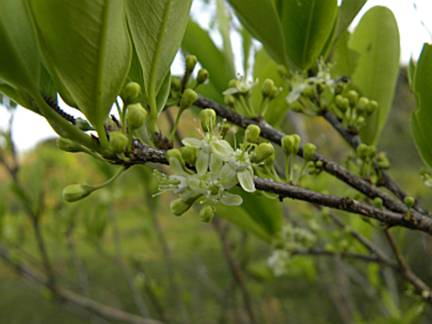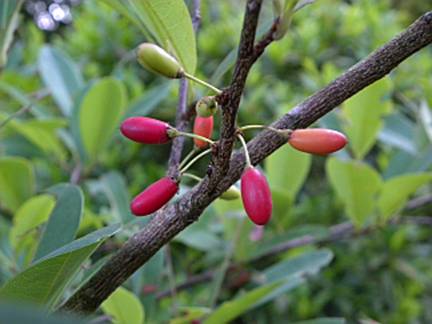ERYTHROXYLUM DECIDUUM
FAMILY OF ERYTHROXILACEAE
|
|
|
|
Flowers |
Fruits |
NOMENCLATUR AND IMPORTANCE: SAGUIMBA comes from the Tupi, and means "fruit or food of Sagui". Also known as Cocão, Fruta de Pomba, Fruta de Sagüi or Baga de Juriti. It is the most popular fruit of the smallest monkeys in South America, especially die'Arten: Callithrix jaccbus, C. penicillatus and C. auritus.
Origin: Native to various forest formations of the coast to the semi-evergreen forests of the high altitudes, most commonly found in primary forests with damp soil. Comes from the northeast prior to Rio Grande do Sul in Brazil. Outside of Brazil, it is found in Argentina and Paraguay. More information in Portuguese at the link:
Features: Shrub 2 to 4 m tall on the sand bank, it can reach in the forest heights of 4 to 8 meters, with a roughly cylindrical or rounded crown with dense foliage, trunk 10 to 25 cm in diameter with vertical cracking, brown and gray bark. This species is easy to recognize by the presence of 5 to 8 mm long, linear (long and thin) and striatal (wrinkled) stipules especially on younger shoots. The leaves are simple and carton-like, bare (hairless) and are green on top and gray-green on the underside. The blade is long (longer than wide) with a blunted tip, 3.5 to 10.5 cm long and 2 to 4.5 cm wide. The flowers appear in axillary clusters or groups, are yellowish-white with 5 petals and stamens and white in the center with green stigma. The fruit is a drupe (a seed), 8 to 14 mm long and 6 to 9 mm in diameter.
Culture tips:Fast-growing plant, prefers red or sandy loam soils which contains larger amounts of organic matter and have a good ability to hold rainwater. It is resistant to light frosts down to -3°C and tolerates drought well. The plant bears fruit both in full sun or shade and should be planted in well-fertilized soil enriched with organic matter. The plant can be grown in the flooded areas. It begins 2 to 3 years after planting to bear fruit.
Propagation: The seeds are small and whitish, can be pulped in a sieve under running water. After drying, they retain their ability to germinate for 6 to 8 months. After sowing, they germinate in 40 to 60 days and it should be sown into the substrate from 50% red soil, 30% organic matter and 20% sand. They should be sown two per pot and then poured daily. The plants grow quickly and are up to 40 cm tall by 8 to 9 months after germination, the seedlings develop in partially shaded locations. This species can also be planted in pots of 50 cm height and 40 cm in diameter, using the same substrate as described above.
Planting: I recommend a planting in full sun or shade at intervals of 4 x 4 m. The holes should measure 50 cm in three dimensions and to be filled with 6 shouvels of organic material mixed well with 500 g of lime and 500 g of wood ash, let them work at least 2 months. The best planting time is from October to November, after planting and during the first 6 months after planting, when it does not rain, water every 15 days with 10 liters of water.
Culture: The plant needs no special treatment, just the soil surface should be covered with dry grass and weeds regularly, so that the plant does not suffocate. Remove the growing shoots and the down intersecting branches in the crown. The best time to cut is the month of August. Fertilize with 2 shouvels of organic compost mixed well with poultry manure and 30 grams of NPK 10-10-10. Distribute nutrients to the surface and 5 cm to 20 cm away from the tree in the month of September.
Use: Bears fruit in the months from October to December. The fruits are red when they are ripe and its taste is reminiscent of kaki and green mango, it can be consumed in kind and can be used for juice and jam production. The flowers provide nectar and pollen for the wild bees and the tree should not be missing in the greening projects because of the food for the bird life in general.
Back to the seedlist (English) or back to Erythroxilaceae (Portuguese)

